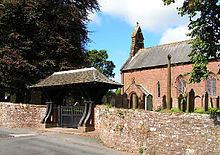OS grid reference NY 072 036 Country England Functional status Active | Denomination Anglican Opened 1899 Architect Charles John Ferguson | |
 | ||
Website achurchnearyou.com/gosforth-st-mary Similar Gosforth Cross, St Michael's Church, Ravenglass Roman Bath Hou, Egremont Castle, St Bees Priory | ||
St Mary's Church in the village of Gosforth, Cumbria, England, is an active Anglican parish church in the deanery of Calder, the archdeaconry of West Cumberland, and the diocese of Carlisle. Its benefice is united with those of St Olaf, Wasdale Head, and St Michael, Nether Wasdale. The church is recorded in the National Heritage List for England as a designated Grade I listed building. It is associated with "a unique Viking-age assemblage" of carved stones.
Contents
History
This has been a Christian site since the 8th century. The oldest fabric in the present church dates from the 12th century. The church was reconstructed in 1789, but most of the fabric currently present is the result of a virtual rebuilding by C. J. Ferguson between 1896 and 1899.
Architecture
St Mary's is constructed in stone with a slate roof. Its plan consists of a nave, a north aisle, a south porch, a chancel and north vestries. The 19th-century rebuilding is in Decorated style. At the west end is a corbelled-out bellcote. The gabled porch leads to the south door, to the right of which is a blocked Norman doorway, formerly on the north side of the church. There is a monument dated 1834 on the exterior of the north wall of the chancel.
Inside the church is a four-bay north arcade, consisting of pointed arches carried on columns with octagonal capitals. The 14th-century chancel arch is set on richly carved Norman capitals.
In a niche at the east end of the aisle are two carved Viking hogback stones. These are very rare pre-Norman tomb markers that were found under the foundations of a 12th-century wall of the church during restoration in 1896-97. The early 11th century is the latest possible date. The hogbacks are each in the shape of a house. The larger tomb has on its sides humans astride smaller serpents battling with larger serpents. The smaller stone has two armies thought to be concluding a truce.
In and around the niche, and in the porch are other fragments of medieval stones. The small octagonal font dates from the 19th century. Also in the church is a Chinese bell dating from 1839, which was captured from the Anunghoy Fort in the Battle of the Bogue (1841) on the Canton River. It was donated to the church in 1844.
One of the stone slabs is the so-called "Gosforth fishing stone" and is presumably the same artist who carved the cross, outside. It represents Thor and the giant Hymir, fishing for Jörmungandr, the serpent which encircles the world. It is possibly a remnant of another cross.
The stained glass dates mainly from the late 19th century, most of which is by Ward and Hughes. The two-manual pipe organ was made by Conacher and Company of Huddersfield, and rebuilt and expanded in 1984 by Sixsmith.
